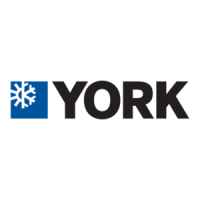4
Unitary Products Group
RE–ASSEMBLING, BRAZING AND
CLEANING OF JOINT CONNECTIONS
When
using hard solder
, an inert gas such as dry ni
-
trogen must be introduced and permitted to flow
through tubing during brazing to displace air and
prevent
oxidation.
Remove the Schrader valve cores from the service
valves. Remove the plugs from the service valve field
tubing
connections. Clean the joints to be brazed.
NOTE:
Do
not
overheat the connection to be brazed as
this can cause improper flow of solder
, resulting
in a weak and leaking joint. Never apply heat
directly to face of fitting. Do not heat solder by
direct
contact with flame of the torch.
When brazing copper tubing it is very important to pre-
heat the entire joint before applying the solder. This is
done
by sweeping the
flame steadily and evenly around
the
fitting, to bring both fitting and tubing up to equal tem
-
perature
before applying the solder
.
Reassemble
groups of tubing and fittings, brazing sever
-
al joints instead of one joint at a time. This reduces the
chance for error in the alignment of the assembly. Re-
place schrader valve cores. DO NOT OPEN SERVICE
VALVES
A
T THIS TIME.
NOTE:
Do
not heat solder by direct contact with flame of
the
torch.
INSULATION OF VAPOR LINE
Insulate vapor line with 3/8” (or that required by local
code)
closed cell insulation.
Slide
tubing insulation onto the vapor line so that it is cov
-
ered completely from the indoor coil to the outdoor unit.
Be
sure that the tubing is capped before sliding on insula
-
tion.
It
is not necessary to insulate the liquid line.
FIGURE 2
– INSULA
TION OF V
APOR LINE
INCORRECT
CORRECT
LIQUID
LINE
TAPE
SHEET
MET
AL HANGER
INSULA
TED V
APOR LINE
NOTE:
In
areas of extreme temperatures and humidity
,
additional
insulation may be required to prevent
excessive
condensation and loss of capacity
.
Do
not insulate liquid line
and vapor line together
. Liquid
line
should not be in contact with the vapor line. See Fig
-
ure
2.
REFRIGERANT LINE SUPPORT
Refrigerant lines should be supported in a way that no
dips or sags occur. We recommend four feet between
supports. If refrigerant lines are to be attached to the
home structure, care should be taken to eliminate the
transmission
of vibrations. Attach the refrigerant lines to
the indoor coil first. Remove plugs from the indoor coil,
then
clean joints to be brazed. Braze refrigerant lines to
the
indoor coil.
Attach refrigerant lines to the outdoor unit.
CHARGING AND LEAK TESTING
On
systems with or without service valves the refrigerant
should be recovered or recycled in accordance with EP
A
regulations.
In some cases
this may require putting pierc
-
ing
valves on
both the high and low sides of the system.
DO
NOT
vent refrigerant to the outdoors.
When
recovering refrigerant from a system, with a burn
-
out,
follow a safe procedure due to possible contamina
-
tion.
Avoid getting the refrigerant in the eyes or on the
skin.
Contaminated refrigerant must be recovered and re-
turned to the local refrigeration supply house for proper
disposition.
TOTAL LINE LENGTH
Units
should be installed
only with approved system com
-
bination (indoor/outdoor) as specified in the Technical
Guide.
For
systems with
total line length exceeding 50 feet, see
APPLICATION DATA, 690.01–AD1V(1296) and work-
sheet 690.01–AD1.1V(791) “General Piping Recom-
mendations and Refrigerant Line Length” for vapor and
liquid
line sizing, calibration of liquid line pressure loss or
gain,
determination of vapor line velocity
, elevation limita
-
tions,
orifice connections, system charging, traps, etc.
System with liquid line pressure loss or gain grater than
11 psi must be provided with corrected orifice size as
noted
in Form 690.01 – AD1V (1296).
ORIFICE SELECTION
NOTE:
The
proper orifice must be installed in the indoor
coil
liquid line connection prior to the connection
of
the refrigerant lines.
The
indoor coil is under 35 psig
(inert gas) pressure.

